
The cobalt blue tarantula or Cyriopagopus lividus is a species of tarantula which is in the family Theraphosidae which is native to Myanmar and over the border into Thailand. It was originally described as Haplopelma lividum.

The lesser black krait is a species of venomous elapid snake found in India, Bangladesh, and Nepal. The specific epithet is after Latin lividus, meaning “bluish metal-colored” or “lead-colored”, referring to the snake's coloration.

Conus lividus, common name the livid cone, is a species of sophisticated predatory sea snails, marine gastropod molluscs in the family Conidae, the cone snails, cone shells or cones.
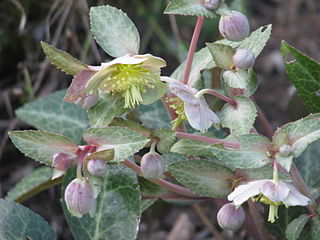
Helleborus lividus is a species of flowering plant in the family Ranunculaceae, native to Majorca and possibly nearby Cabrera, Spain. It is an evergreen perennial growing to 45 cm (18 in) tall by 30 cm (12 in) wide, with deep green or bluish green, glossy leaves and light green or pinkish-green flowers opening nearly flat and appearing from midwinter to early spring. The Latin lividus refers to the colour of the leaves. It may be best grown in a greenhouse in frost-prone areas. Propagation is from seed.
Pristimantis lividus is a species of frog in the family Strabomantidae. It is endemic to Ecuador. Its natural habitat is tropical moist montane forests. It is threatened by habitat loss.

The great shrike-tyrant is a species of bird in the family Tyrannidae. It is found in Chile and adjacent areas of south-western Argentina.
Haplochromis lividus is a species of cichlid endemic to Lake Victoria. This species can reach a length of 9 centimetres (3.5 in) SL.
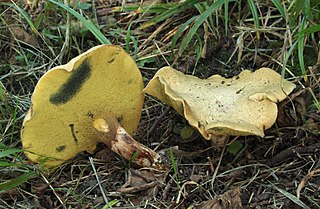
Gyrodon lividus, commonly known as the alder bolete, is a pored mushroom bearing close affinity to the genus Paxillus. Although found predominantly in Europe, where it grows in a mycorrhizal association with alder, it has also recorded from China, Japan and California. Fruit bodies are distinguished from other boletes by decurrent bright yellow pores that turn blue-grey on bruising. G. lividus mushrooms are edible.
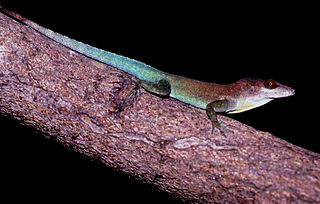
Anolis lividus, the Plymouth anole or Montserrat anole, is a species of anole lizard that is endemic to the island of Montserrat in the Caribbean Lesser Antilles. It is widespread and abundant in many areas.
Potamonautes lividus, also known as the blue river crab, is a species of decapod in the family Potamonautidae. P. lividus is endemic to the country of South Africa in a area of 200 kilometers squared. The species prefers inland freshwater bodies in wetlands, bogs, marshes, freshwater swamp forests and peatlands (mire). P. livisus is found most often in the province Kwa-Zulu Natal in South Africa with the species also living in Richards bay, Ntambanana, Mtubatuba and uncoifirmed sighting in the Amatikulu river which if confirmed, represents the southern most members of the Potamonautes lividus species.

Paracentrotus lividus is a species of sea urchin in the family Parechinidae commonly known as the purple sea urchin. It is the type species of the genus and occurs in the Mediterranean Sea and eastern Atlantic Ocean.
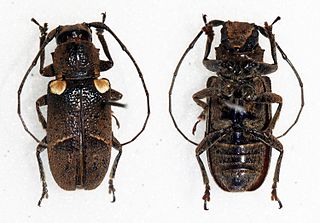
Prosoplus is a genus of longhorn beetles of the subfamily Lamiinae, containing the following species:
Prosoplus atlanticus is a species of beetle in the family Cerambycidae. It was described by Stephan von Breuning in 1938.
Prosoplus rugulosus is a species of beetle in the family Cerambycidae. It was described by Stephan von Breuning in 1938.
Prosoplus imitans is a species of beetle in the family Cerambycidae. It was described by Stephan von Breuning in 1961.
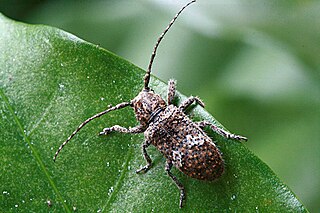
Rhytiphora bankii is a species of beetle in the family Cerambycidae. It was first described by Johan Christian Fabricius in 1775, under the genus Lamia. It is known from Australia, the Philippines, Borneo, Java, Micronesia, New Guinea, Hawaii, Moluccas, Sumatra, Vietnam, and has been introduced into Japan. The Australian species of Prosoplus were synonymised with Rhytiphora in 2013.
Prosoplus costatus is a species of beetle in the family Cerambycidae. It was described by Karl-Ernst Hüdepohl in 1996. It is known from Borneo and Malaysia.
Prosoplus kambangensis is a species of beetle in the family Cerambycidae. It was described by Stephan von Breuning and de Jong in 1941.
Prosoplus sinuatofasciatus is a species of beetle in the family Cerambycidae. It was described by Blanchard in 1855.
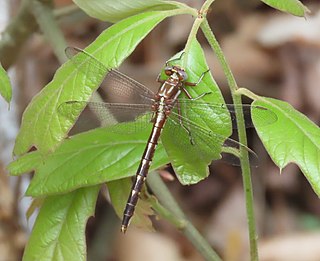
Phanogomphus lividus, the ashy clubtail, is a species of clubtail in the dragonfly family Gomphidae.










